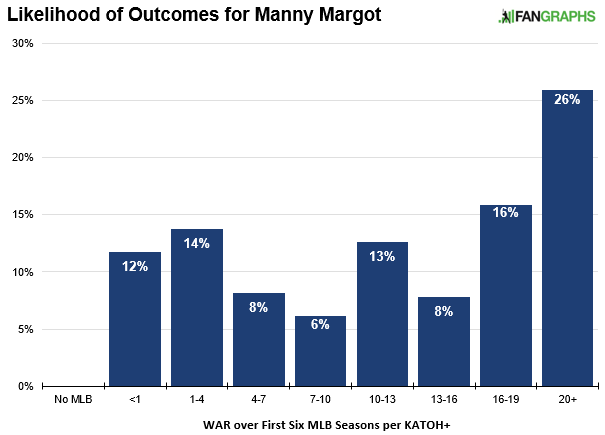Projecting Manny Margot and Other Padres Call-Ups
Following the end of their Triple-A affiliate’s championship season in the Pacific Coast League, the San Diego Padres promoted a small collection of players to their major-league club on Tuesday. Below are forecasts for the three most notable prospects of that group — Carlos Asuaje, Hunter Renfroe, and Manuel Margot — according to my KATOH system and presented in order of projected WAR.
Note that KATOH represents the WAR projection for the relevant player’s first six years in the majors; KATOH+ is that same thing, except with the player’s Baseball America ranking included as a variable.
*****
Manny Margot, CF (Profile)
KATOH: 13.0 WAR
KATOH+: 13.6 WAR
Margot’s game centers around speed and contact. The 21-year-old struck out in just 12% of his plate appearances in Triple-A this year on his way to a .307/.355/.442 slash line. He also racked up an exciting 32 steals, while playing elite center field defense by Clay Davenport’s numbers. Margot also isn’t a zero in the power department, as he managed a respectable 46 extra-base hits in the minors this year, including seven homers. He’s one of the very best prospects in baseball by my math, and he’s big-league ready.
To help you visualize what his KATOH projection entails, here is a probability density function showing KATOH+’s projected distribution of outcomes for Margot’s first six seasons in the major leagues.

To put some faces to Margot’s statistical profile, let’s generate some statistical comps for the speedy outfielder. I calculated a weighted Mahalanobis distance between Margot’s performance this year and every Triple-A season since 1991 in which a center fielder recorded at least 400 plate appearances. In the table below, you’ll find the 10 most similar seasons, ranked from most to least similar. The WAR totals refer to each player’s first six seasons in the major leagues. A lower “Mah Dist” reading indicates a closer comp.

